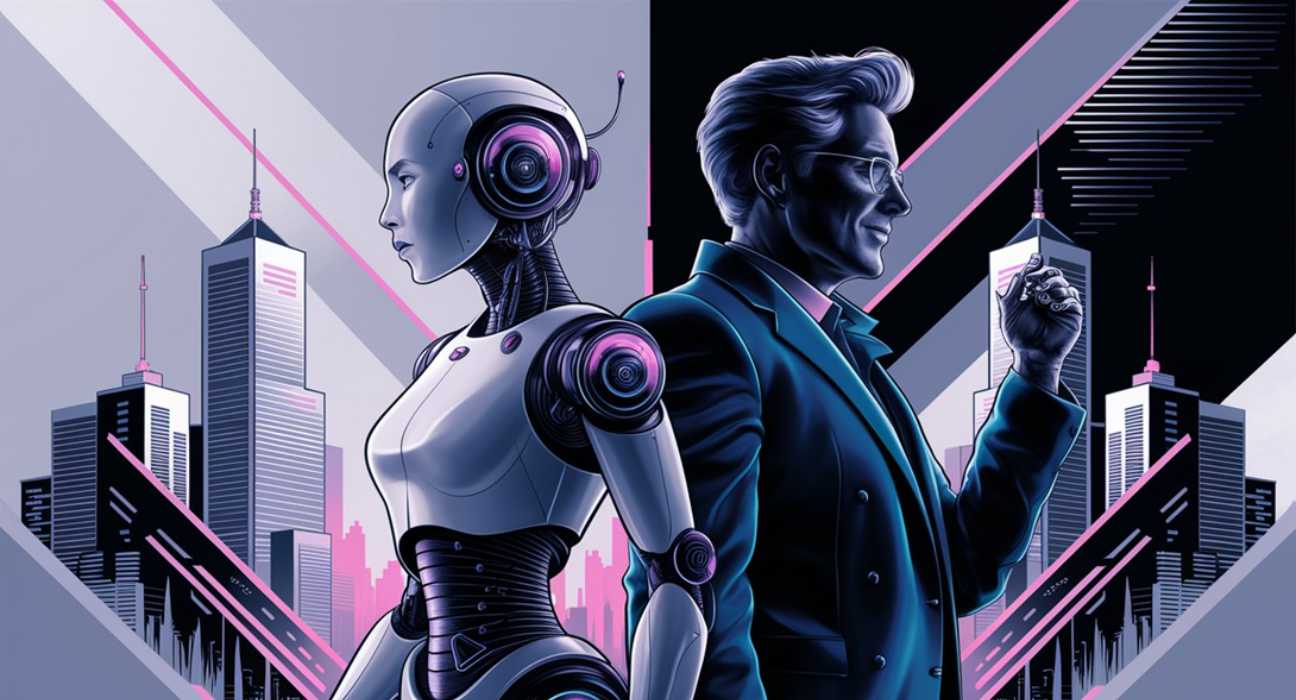AI and Leadership
One of the most change-impacting phenomena in this 21st century has been AI infusing into different sectors. With industries and businesses embracing more and more AI technologies, how leadership is exercised undergoes a dramatic change. Many opportunities and challenges lie at the junction of AI and leadership, which call for a new look—with some considerable revaluation—at traditional roles and strategies of leadership. The article is about how the role of leaders is turning into one whereby they increasingly have to function within an AI-enabled working environment.
The Impact of AI on Leadership
Enhancing Decision-Making Processes
Probably one of the most influential phenomena for change in this 21st century has been AI infusing into different sectors. With industries and businesses embracing more and more AI technologies, how leadership is exercised undergoes a dramatic change. There are various opportunities and challenges lying at the junction between AI and leadership, calling for some serious revaluation in regard to traditional roles and strategies of leadership. The article is about how the role of leaders is turning into one whereby they are increasingly working within an environment enabled by AI.
Facilitating Personalized Leadership
AI technologies make personalized leadership possible by providing insight into what each member of a team is good or bad at, and even their individual preferences. Based on this AI-driven insight, a leader can adapt their communication and management style to the specific needs of teams. Thus, with a more inclusive and supportive work environment, there will be increased employee engagement and productivity. Not to mention that AI-empowered tools will trace the gap in skills and solve once and for all the development of relevant training programs to move forward in terms of continuous professional development.
Streamlining Operational Efficiency
Where AI meets leadership is operational efficiency. With AI comes the advantage of automating routine tasks so that the leader can focus on high-value strategic activities. With RPA, leaders are released from spending time on repetitive administrative tasks and are charged with time for more critical responsibilities. Besides, AI-driven project management tools make workflow management more efficient and agile by smoothing workflow execution, optimizing resources, and boosting collaboration.
The Evolving Skill Set of AI-Driven Leaders
Technological Proficiency
Leaders in an AI-influenced age need an idea of AI technologies and their application areas. That certainly would not mean one is expected to be a programming or data science champion, but the basic ideas of AI concepts come as a minimum requirement. It includes, above all, knowledge of how AI algorithms work, the potential and limitations, and ethical considerations for AI implementations. Leaders have to know what is happening in new developments in AI and for making wise choices of adoption and integration.
Data Literacy
In becoming AI-driven leaders, data literacy is one of the most important competencies. How to interpret and analyze data has paramount sitting in the effective use of AI insights. Leaders have to develop an ability for applying data analytics tools and techniques, extracting meaningful information from large data sets. This would imply knowledge of key metrics, data visualization, and statistical analysis. Data-driven decision-making calls for a leader to navigate complex data sets in identifying patterns and trends that will inform strategic initiatives.
Emotional Intelligence
Significantly, while AI makes many dimensions of leadership effective, the threshold of emotional intelligence remains unaffected. It places a strong emphasis on elements of empathy, communication, and human touch—elements that must be balanced between AI and leadership. The leaders who have a high-rated EI possess competencies for managing relationships between individuals, resolving conflicts, and motivating their groups. Such leaders, having higher emotional intelligence, will fill up the gap created by technology, for in this age of AI-driven workplaces, at times one is alienated from the other, and they will create a coherent identity with high motivation in their workforce.
Adaptability and Agility
Leaders need to be very adaptable and agile because of fast technological changes. AI and leadership require a mindset characterized by innovation and learning. Leaders have to be open to testing new technologies and trying strategies several times, changing fast in the light of developing market conditions. This agility allows leaders to stay ahead in their competition area and act on business opportunities found in a dynamic environment. An adaptable leader is also capable of successfully leading an organization through all the issues and uncertainties involved in the process of adoption of AI.
Challenges in the AI-Driven Leadership Landscape
Ethical Considerations
Where AI and leadership come together is on the ground of ethics. Deployment of the technologies of AI raises a host of ethical concerns related to privacy, bias, and accountability. Leaders must navigate these ethical questions so AI works responsibly and transparently. This goes for checking bias in AI algorithms, ensuring the protection of data privacy, and setting clear guidelines for AI usage. That is to say, AI-age ethical leadership has to balance technological innovation with a commitment to ethical standards and social responsibility.
Workforce Displacement and Reskilling
That could also mean that, because of AI entering the workplace, some kinds of jobs will be entirely displaced—about which the concerns of workforce displacement ought to come forward. It is an issue of leader responsibility to address this concern by creating a culture of continuous learning and upskilling. Leaders could make huge efforts by providing workers possibilities to acquire new skills relevant to changing roles today, hence reducing the impact of AI on workforce bodies. This proactive method will help workers still be relevant and useful in an AI-driven economy. In addition, leaders should also display transparency in plans while implementing AI and engage employees in transition procedures.
Managing AI-Human Collaboration
Effective collaboration between AI and human workers would be what would actually maximize the potential benefits from AI. Leaders need to have an environment where AI augments humans, not replaces them. In other words, it means knowing which tasks are better suited for AI automation and those that drive human intuition and creativity. Such leaders must instil a culture of collaboration whereby AI and human workers work things out seamlessly in executing organizational goals. Moreover, the most desirable form of investment is in employee AI literacy training programs and equipping skills to work with AI technologies.
Case Studies: AI and Leadership in Action
IBM’s Watson and Leadership Transformation
A classic example of AI and leadership convergence is IBM’s Watson. It is an artificial intelligence system answering questions posed in natural language and instrumental in changing the aspect of leadership at IBM. With Watson’s data analytics, leaders at IBM derive actionable insights into market trends, customer preference, and operation efficiencies. It’s through Watson that leaders at IBM can drive innovation and growth by making data-driven decisions. Watson also contributes to talent management through the analysis of employee performance data and the identification of opportunities with regard to development and engagement.
Google’s AI-Driven Leadership Approach
AI dominates the thinking process of Google’s leadership. For any single operation, be it product development or customer service, the company relies on AI in its optimization. Google’s AI algorithms are run against large amounts of data to know user preferences and deliver experiences that are much more personalized. This attack, being data-driven, is what helps the leaders at Google stay ahead of market trends and come up with solutions that are innovative. The facets of AI tools in use at Google enhance collaboration and productivity in teams, and thus leadership integration can efficiently manage complex projects.
General Electric’s AI Integration for Operational Excellence
General Electric has infused AI into its leadership strategy in the quest for operational excellence. AI-driven predictive maintenance systems from GE study data from industrial equipment to predict failures and optimize maintenance schedules to help reduce downtime and improve operational efficiency. AI insights at GE empower leaders to make bundling decisions on resource allocation, supply chain management, and product development. By adopting AI, it has made GE’s leadership more agile and data-driven.
The Future of AI and Leadership
AI Augmented Leadership
The future of AI and leadership is augmentation—continuous support, not replacement. AI will empower leaders and enhance their potential by giving them new tools to drive decision-making, strategic planning, and operational efficiencies. AI-powered insights will help leaders wrestle with difficult challenges, foresee market changes, and innovate. But the human elements in leadership will never be machine-replaceable. Emotional intelligence, creativity, and ethical judgment are qualities simply out of reach for AI alone. That is to say, the most successful leader will be those in a position to faultlessly and seamlessly integrate AI into their leadership with a very strong focus on human values.
Continuous Learning and Development
AI technologies are fast evolving, and thus leaders have to continuously develop themselves to cope with the new system. Lifelong learning will be important in remaining relevant and effective throughout the times of constant increases in changes in the AI technological context. Leaders have to invest in their own education by studying the latest developments in AI and various connotations they can have. Basically, organizations should create a culture in which continuous learning is promoted at all levels for a more-adequate response to the changes being caused in technologies by employees. Emphasizing learning and development allows leaders to ensure that their organizations are sustainable and competitive within an AI-driven world.
Ethical and Responsible AI Leadership
The key to ethical and responsible AI leadership, therefore, cannot be overemphasized with AI this deep in concatenation in leadership practices. Leading must major in AI implantation transparencies, accountabilities, and fairness. This gives a set of ethical guidelines on the use of AI, where algorithms should be unbiased and fair, and data privacy should be stringently safeguarded. Moreover, ethical AI leadership has to consider the broader societal impact of AI regarding issues such as workforce displacement and social inequality. Leaders can establish trust with their stakeholders and cause a positive impact on society through the espousal of ethical principles.
Conclusion
The AI era is such that it may be considered the most transformative time for leadership. AI and leadership are not running on divergent lines; they can have convergent ways toward better decision-making, operational efficiency, and personalized management. With this convergence come problems associated with ethical considerations, workforce displacement, and new skills. Therefore, the future of AI and leadership lies in augmentation—that is, AI empowering leaders in their tasks while retaining the most essential human qualities of empathy, creativity, and ethical judgment. Provided that leaders took the challenge of continuous learning and adopting the basis of ethical principles, they can be successful in managing the opportunities of this evolving AI landscape and create positive change within organizations and society at large.











